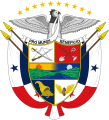Winged wheel

A winged wheel is a symbol used historically on monuments by the Ancient Greeks and Romans and more recently as a
History
The symbol is considered to be distinct from the older winged circle symbol which was commonly used in Mesopotamian and Assyrian symbolism.[1] It was used by the ancient Greeks as a symbol of Hermes, the herald of the Gods, but despite this it is relatively rare on surviving Greek and Roman monuments.[2][1] When it does appear it is mainly as an abbreviation or indication of a chariot or to symbolise motion. The winged wheel is often used to represent the fabled chariot or velocipede of the Greek god Triptolemus.[1]
Use in heraldry
The winged wheel is used in heraldry, though plain wheels (usually cart wheels) and
When included in heraldric arms they are often emblems of engineering or transport; for example in the arms of the Institution of Municipal Engineers.[8][9] However other meanings have included representing railroads, steam power, tourism, speed and progress.[10][5][11] The device has also been used to represent the Holy Spirit of the Abrahamic religions.[12]
A two-winged wheel was the logo of the
A winged wheel symbol has been used in other contexts as various as the coat of arms of Panama and of the city of Edmonton in Canada, the flag of Knoxville, Tennessee, the badge of the Ohio State Highway Patrol, the collar badge of Polish railway troops, the emblem of Russian Railway Troops, and the logo of Rotary Watches.
The Detroit Red Wings ice hockey team has used a winged wheel in its logo since 1933, when it adopted its current name. Owner James E. Norris drew inspiration for the logo from the Montreal Amateur Athletic Association, whose athletes wore a similar design.[14]
In addition to his associations with movement and swiftness Hermes has medical associations (for example through his Caduceus staff). This led to the winged wheel's adoption by the US Army's 2nd Surgical Hospital, where it represented the unit's role in evacuating the wounded.[2]
-
The three-wingedCyclists' Touring Clublogo
-
A winged wheel in the fourth quarter of the coat of arms of Panama
-
Collar badge of Polish railway troops
-
Great emblem of the Russian Railway Troops
-
Logo of the Bulgarian State Railways
-
Logo of the Hungarian State Railways
See also
References
- ^ a b c Goblet d'Alviella, Eugène (1894). The migration of symbols. (London) : A. Constable and Co. p. 222.
- ^ ISBN 978-0-87249-963-8.
- ISBN 978-0-8063-0459-5.
- ISBN 978-1-60239-001-0.
- ^ a b "About the Coat of Arms". Aberystwyth Council. Retrieved 26 February 2020.
- ^ a b "The history of the Winged Wheel". Cycling UK. Retrieved 26 February 2020.
- ^ Surveyor. 1931. p. 123.
- ISBN 978-0-7232-2096-1.
- ISBN 978-1-349-00534-5.
- ISBN 978-1-171-71548-1.
- ^ Fenn, Amor (1932). Design and Tradition. Prabhat Prakashan. p. 218.
- ISBN 978-0-7864-6955-0.
- ^ "The Roundel". Transport for London. Retrieved 26 February 2020.
- ^ "How Did They Get to Be the Red Wings?". Live About. 31 December 2018. Retrieved 25 March 2020.





